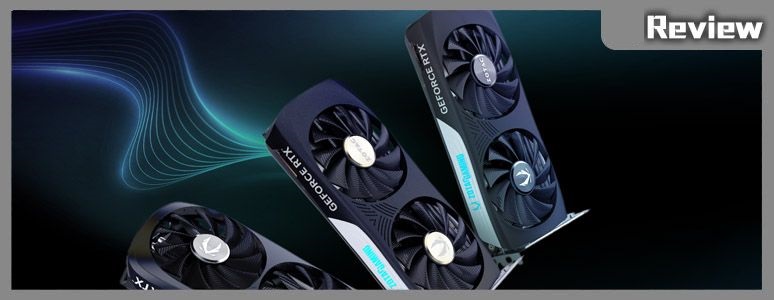
NVIDIA’s RTX 40 SUPER update introduces a superior 4K entry-level option for gamers, with ZOTAC’s compact and powerful ‘GeForce RTX 4070 SUPER TWIN EDGE OC’ gaming graphics card. Measuring just 225.5mm in length and occupying a 2.2-slot installation space, this card features the advanced IceStorm 2.0 cooling system and SPECTRA 2.0 lighting effects. It also incorporates the FireStorm utility, allowing players to adjust the card’s performance and lighting easily. The RTX 4070 Super update enhances the 2K gaming experience and offers a new choice for those looking to enter 4K gaming.
Specifications:
- Graphics Core: NVIDIA GeForce RTX 4070 SUPER
- Bus Standard: PCIe 4.0 x16
- GPU Clock Speeds: Standard MHz, Overclocked MHz
- CUDA Cores: 7168
- Tensor Cores: 224
- RT Cores: 56
- Memory: 12GB GDDR6X
- Memory Interface: 192-bit
- Output Ports: 3 x DisplayPort 1.4a, 1 x HDMI 2.1
- Power Input: 1 x 16-pin
- Total Board Power (TBP): 220W
- Recommended Power Supply: 600W
- Dimensions: 225.5 x 123.2 x 40.1 mm
- Thickness: 2.2 Slot
NVIDIA RTX 40 Super Series Launch: Unveiling the RTX 4070 Super, 4070 Ti Super, and 4080 Super with Advanced Features and Competitive Pricing
The NVIDIA RTX 40 Super series, a significant update in the gaming graphics card market, introduced three new cards: the RTX 4070 Super, available from January 17; the RTX 4070 Ti Super, debuting on January 24; and the flagship RTX 4080 Super, released on January 31. Notably, the RTX 4080 Super is priced at $999, which is $200 less than the initial price of the RTX 4080. The RTX 4070 Ti Super and RTX 4070 Super maintain their pricing at $799 and $599, respectively.
The RTX 4070 SUPER TWIN EDGE OC boasts 56 Streaming Multiprocessors (SM) units, 7168 CUDA cores, 224 Tensor cores, and 56 RT cores. It features a GPU clock speed of 2490 MHz and 12GB of GDDR6X memory. The Total Graphics Power (TGP) consumption has increased to 220W. This model has transitioned to the new PCIe 16-pin power connector, with an adapter included in the package.
The core count in the RTX 4070 Super represents a 22% increase compared to its predecessor, providing a delicate balance in performance. It delivers a 10% performance boost in ray-tracing and DLSS-accelerated games over the RTX 4070, although it is 10% less powerful than the RTX 4070 Ti. This showcases NVIDIA’s expertise in finely tuning its graphics cards.
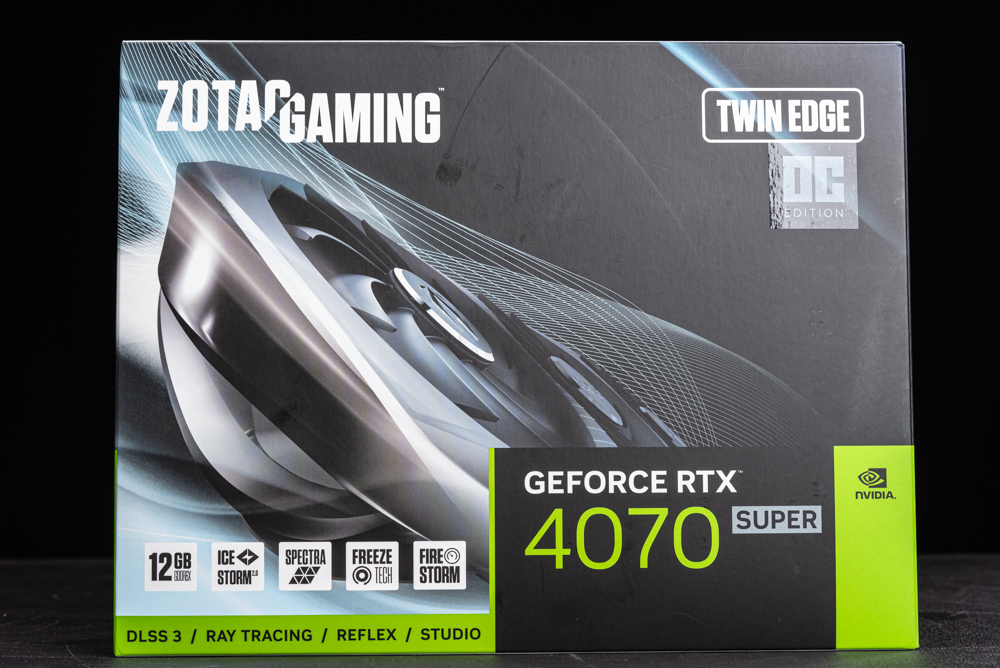
The packaging box for the ZOTAC GAMING GeForce RTX 4070 SUPER TWIN EDGE OC graphics card. The box highlights several features of the card, including:
- 12GB GDDR6X video memory, ensuring ample capacity for modern games and applications.
- IceStorm 2.0, indicating an advanced cooling technology designed to maintain optimal temperatures under load.
- SPECTRA 2.0 RGB lighting, suggesting customizable lighting options for aesthetic customization.
- FREEZE Fan Stop technology, likely referring to a feature where the fans stop spinning under low load to reduce noise.
- FireStorm, which is presumably the utility software provided by ZOTAC for tuning and monitoring the graphics card.
Also mentioned are support for DLSS 3, Ray Tracing, NVIDIA Reflex, and NVIDIA Studio, which are technologies provided by NVIDIA to enhance gaming and creative performance. The “OC Edition” branding suggests this model is factory overclocked for enhanced performance out of the box.
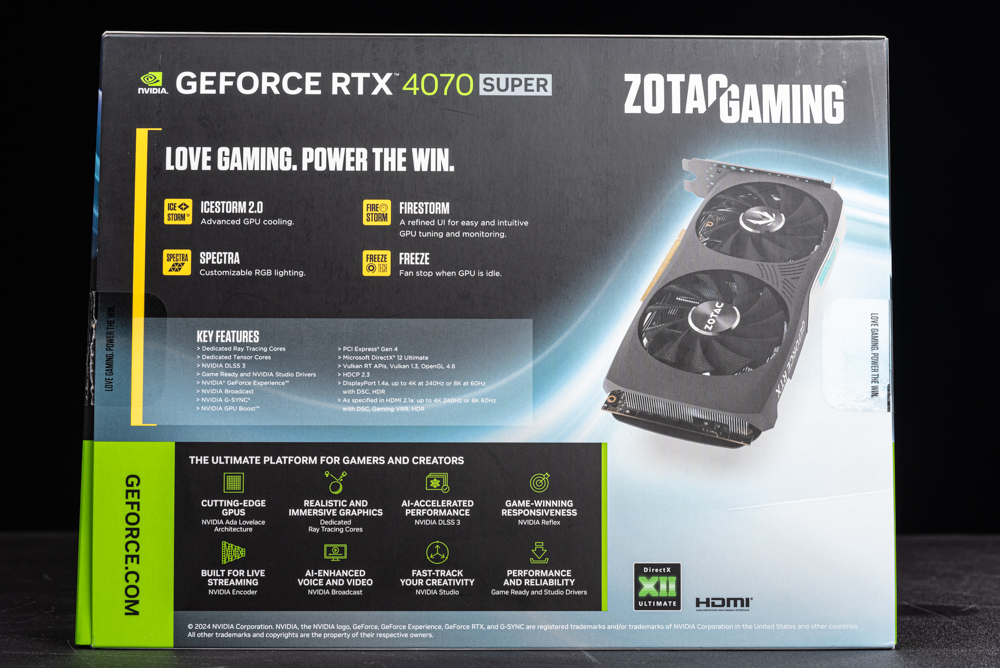
The back of the packaging for the ZOTAC GAMING GeForce RTX 4070 SUPER graphics card. It provides more details about the product’s features and technologies that enhance gaming performance. The key highlights include:
- IceStorm 2.0: An advanced GPU cooling system.
- SPECTRA: Customizable RGB lighting for personalization.
- FireStorm: A fine and intuitive GPU tuning and monitoring software.
- FREEZE Tech: A fan control system that stops the GPU fan in low-load conditions to reduce noise.
Key features also noted on the packaging:
- Dedicated ray tracing cores.
- GDDR6X memory.
- NVIDIA DLSS and NVIDIA Studio Drivers.
- PCI Express Gen 4 support.
- Microsoft DirectX 12 Ultimate.
- 4K HDR, VR Ready.
- DisplayPort 1.4a and HDMI 2.1 support.
The packaging emphasizes “THE ULTIMATE PLATFORM FOR GAMERS AND CREATORS,” highlighting various NVIDIA technologies such as:
- Cutting-edge NVIDIA Ampere architecture.
- Realistic and enhanced graphics.
- AI-accelerated performance.
- Game-winning responsiveness with NVIDIA Reflex.
- Performance and reliability.
- Built for live streaming and AI-enhanced voice and video.
- Fast-track creativity with accelerated apps and NVIDIA Studio.
The ZOTAC GAMING GeForce RTX 4070 SUPER TWIN EDGE OC graphics card features a sleek design with a striking gold fan logo, fitting for gamers who appreciate both aesthetics and functionality in their gaming setup. With a compact length of just 225.5mm, it occupies 2.2 slots within a computer case, making it a versatile fit for various build sizes. The cooling solution is bolstered by a pair of 9cm fans coupled with the IceStorm 2.0 cooling system, designed to maintain optimal performance by efficiently dissipating heat during intense gaming sessions.
An added touch of style is evident on the side of the card, where the ZOTAC GAMING logo is illuminated by SPECTRA RGB lighting effects, allowing gamers to customize their rig’s lighting scheme to match their personal style or mood. This feature not only enhances the visual appeal of the setup but also allows for a personalized gaming experience.
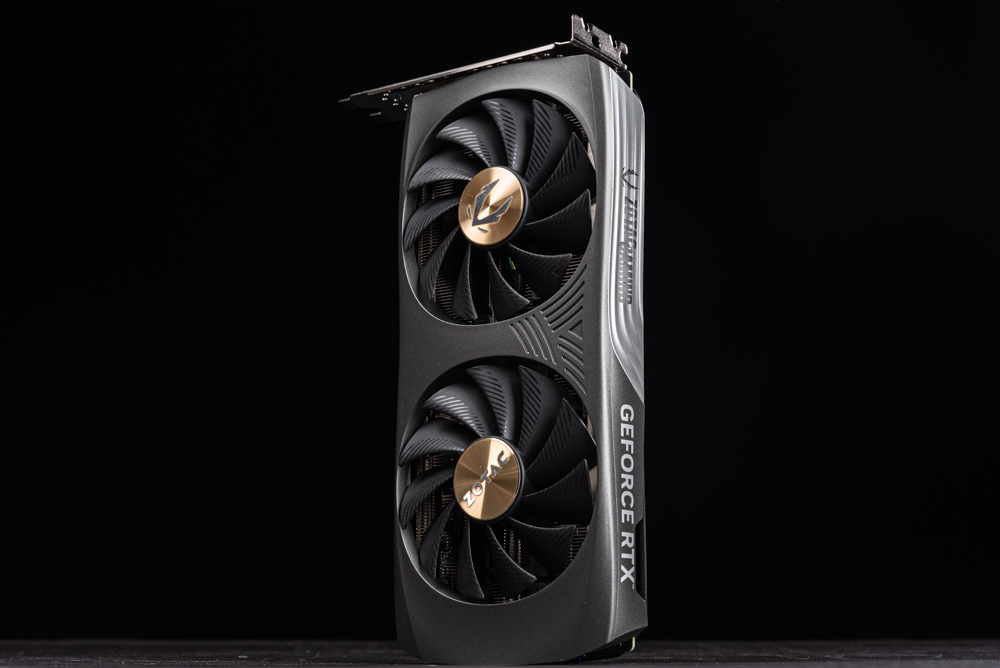
The visual design is quite striking with two prominent, gold-colored fan logos that stand out against the card’s dark chassis. This card embodies both performance and style with its dual-fan setup that not only ensures efficient cooling but also contributes to the overall aesthetic appeal of the hardware.
The sleek black design is complemented with subtle gray accents, and the branding is clearly visible with the “GEFORCE RTX” logo along the side. This design not only serves a functional purpose but also has a strong visual impact, likely to catch the eye of any PC gaming enthusiast or system builder looking for a blend of performance and elegance in their setup.
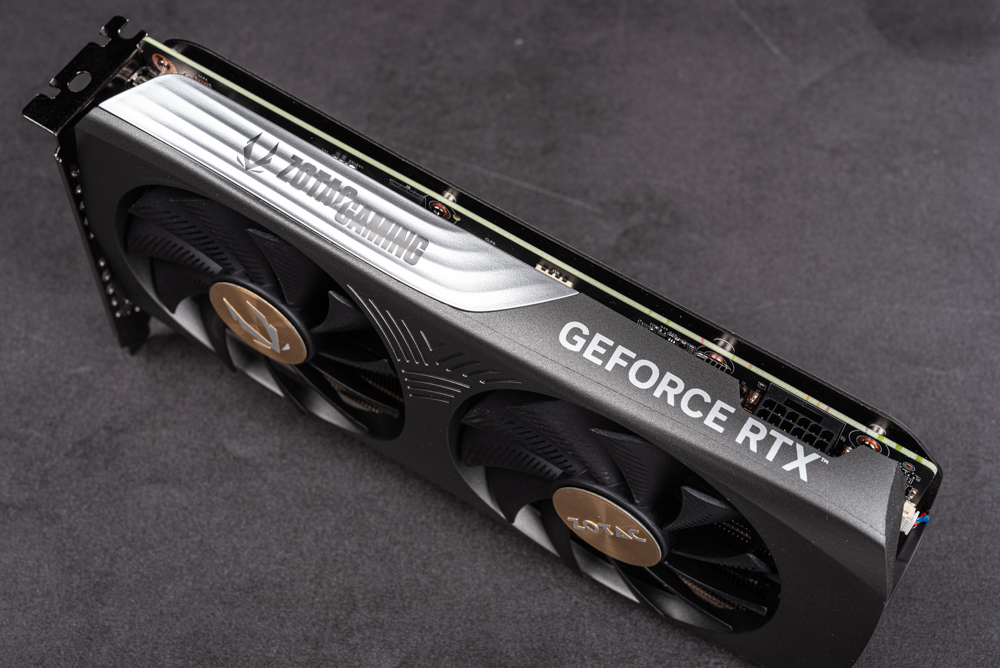
The side view of the ZOTAC GAMING GeForce RTX 4070 SUPER TWIN EDGE OC graphics card, shows off its meticulous design and branding. The side is adorned with the embossed “ZOTAC GAMING” logo, which is backlit, presumably by the SPECTRA RGB lighting system, offering customization of lighting effects to match the user’s gaming rig and personal style.
The blend of silver and black on the card provides a modern and sophisticated look that sets it apart from the conventional graphics card design. This stylish side profile not only showcases the card’s aesthetic but also indicates the potential for a visually cohesive and impressive build, especially when paired with a case that has a transparent side panel.
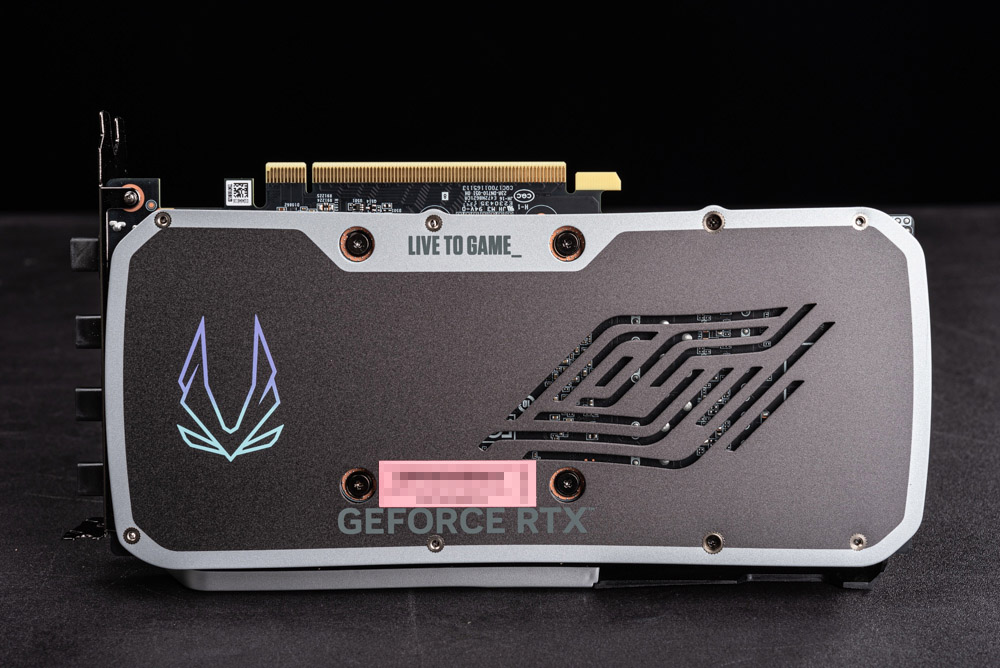
The metal backplate of the ZOTAC GAMING GeForce RTX 4070 SUPER TWIN EDGE OC graphics card. The backplate features a robust and premium design with the slogan “LIVE TO GAME,” indicating the brand’s commitment to gaming excellence. The sleek metallic finish, combined with the ZOTAC GAMING emblem and the NVIDIA GEFORCE RTX logo, exudes a sense of durability and quality.
Backplates like this not only add to the visual appeal of the card but also contribute to its structural integrity, protecting the PCB and components from damage and helping with heat dissipation. The cut-out patterns on the backplate are not just for aesthetics but can also enhance airflow, potentially contributing to better thermal performance.
The graphics card has been updated to include a modern power interface, switching from the standard to a new PCIe 12+4 pin connector. This connector is a part of the latest power delivery standards that aim to supply higher wattage to support the increased power demands of modern GPUs. The inclusion of a converter cable that adapts the new PCIe 12+4 pin to two traditional PCIe 8-pin connectors is a thoughtful addition, ensuring compatibility with existing power supply units (PSUs) that may not yet have the newer connectors.
The design of the new PCIe 12+4 pin connector with its metal pins positioned closer to the edge of the terminal is an engineering consideration to ensure a more secure and complete contact with the motherboard’s pins. This feature emphasizes reliability in the power connection, which is crucial for stable performance, especially under heavy loads such as gaming or intensive graphic workloads.
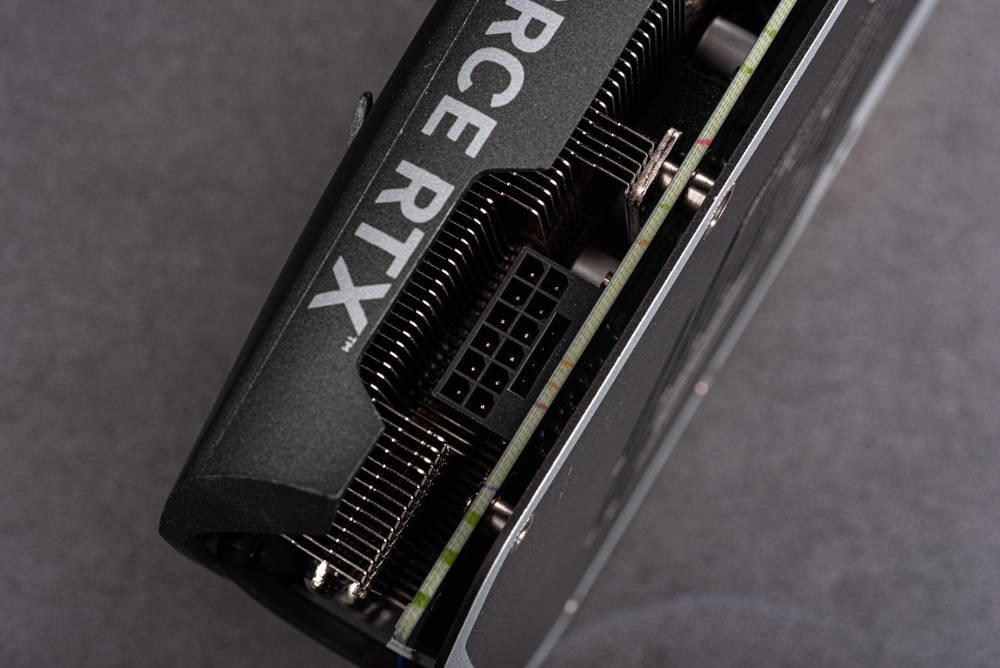
The power connector on the ZOTAC GAMING GeForce RTX 4070 SUPER TWIN EDGE OC graphics card, which employs a PCIe 12+4 pin configuration. This is a modernized approach to power delivery, designed to handle the higher power requirements of cutting-edge GPUs while also simplifying cable management.
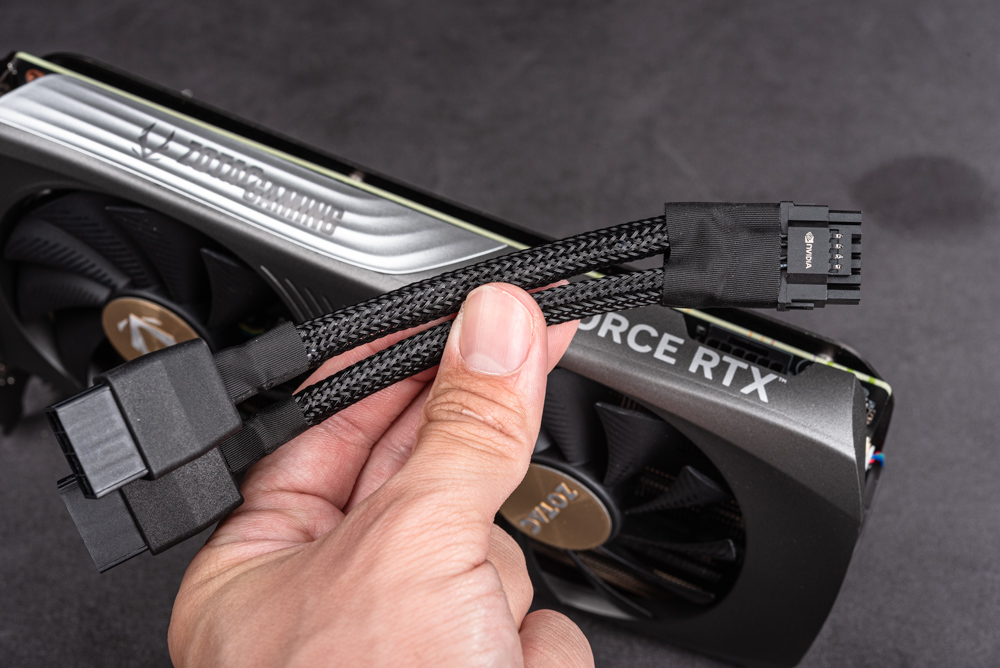
An adapter cable that converts the new PCIe 12+4 pin connector to two 8-pin PCIe connectors, which is a practical accessory for ensuring compatibility with power supplies that have not yet adopted the new power delivery standard. This braided cable not only provides the functional role of power conversion but also adds a premium aesthetic with its sleek, black braiding which is often preferred by builders for a cleaner look inside their PC cases.
The adapter ensures that users can still use the ZOTAC GAMING GeForce RTX 4070 SUPER TWIN EDGE OC graphics card with their current power supplies without the need for an immediate upgrade, providing a bridge between current and emerging hardware technologies.
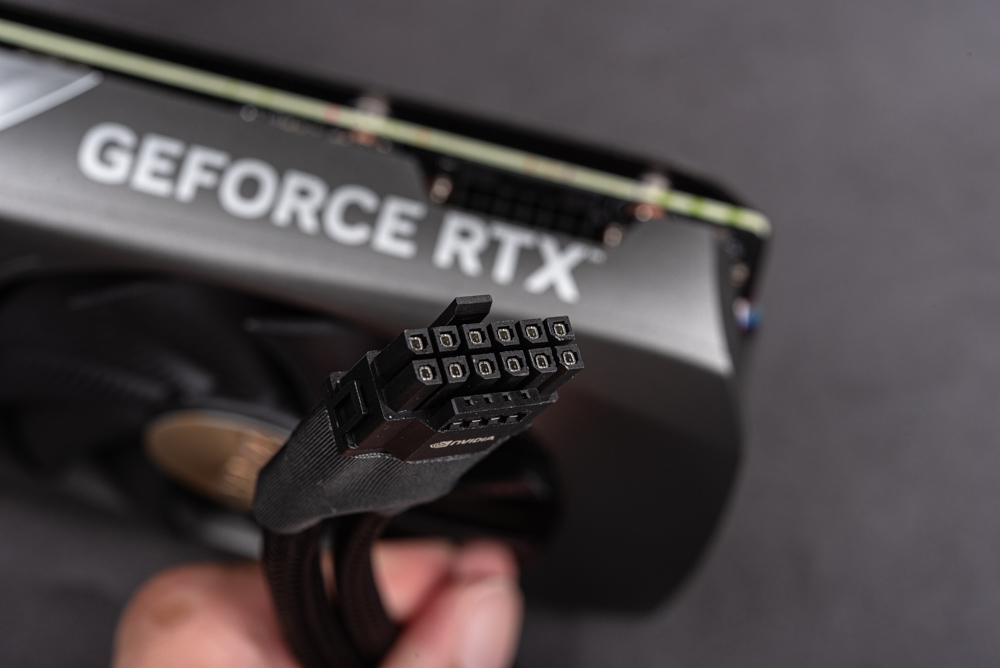
The connector end of the adapter cable with a focus on the metallic pin housing, which is designed to be closer to the terminal end. This design detail ensures that when the connector is plugged into the graphics card, there is a secure and complete electrical contact between the pins of the cable and the receiving pins on the card.
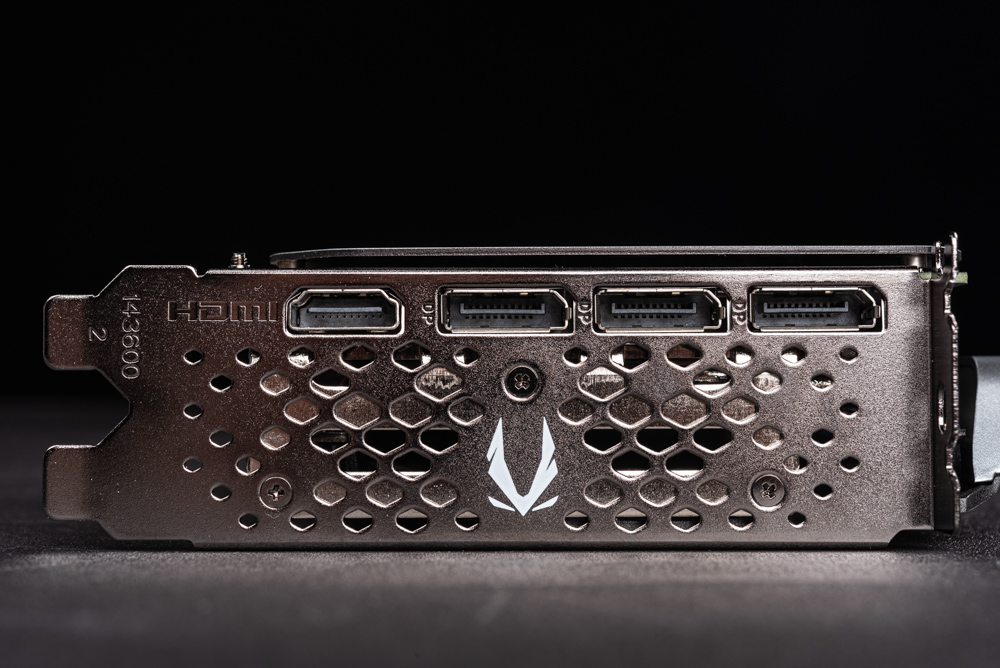
It features a variety of ports, including three DisplayPort 1.4a outputs and one HDMI 2.1 port. This configuration allows for a multi-monitor setup, capable of connecting up to four external displays simultaneously, which is ideal for an expansive gaming setup, multi-task workflows, or an immersive entertainment system.
The presence of both DisplayPort and HDMI ports ensures broad compatibility with a wide range of monitors, from high-refresh-rate gaming monitors to high-resolution TVs. HDMI 2.1 is particularly notable for supporting higher bandwidth, which is necessary for 4K displays at 120Hz or 8K displays at 60Hz, as well as features like dynamic HDR.
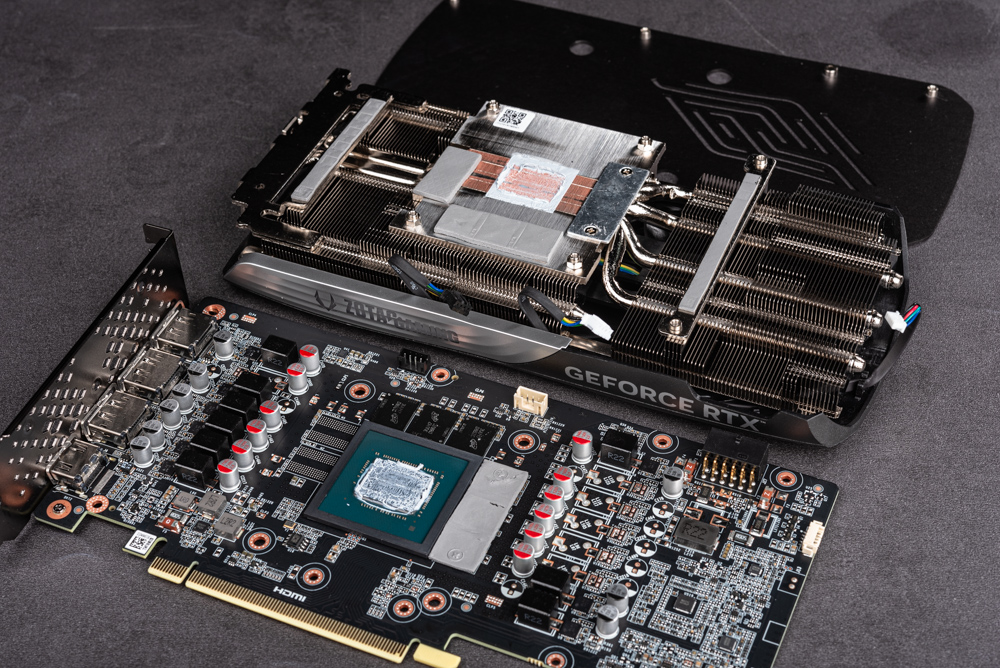
The NVIDIA GeForce RTX 4070 SUPER TWIN EDGE OC by ZOTAC, when disassembled, reveals its core components: the AD104-350-A1 GPU chipset and six GDDR6X memory modules that collectively provide a total of 12GB of video memory. This configuration is indicative of a high-performance graphics card designed to deliver excellent gaming and rendering performance.
The AD104-350-A1 GPU lies at the heart of the card’s capabilities, powering advanced features such as real-time ray tracing and AI-driven processes like DLSS (Deep Learning Super Sampling). The use of GDDR6X memory is also noteworthy, as this type of memory is faster and more efficient than its predecessors, offering higher bandwidth and better performance for memory-intensive tasks.
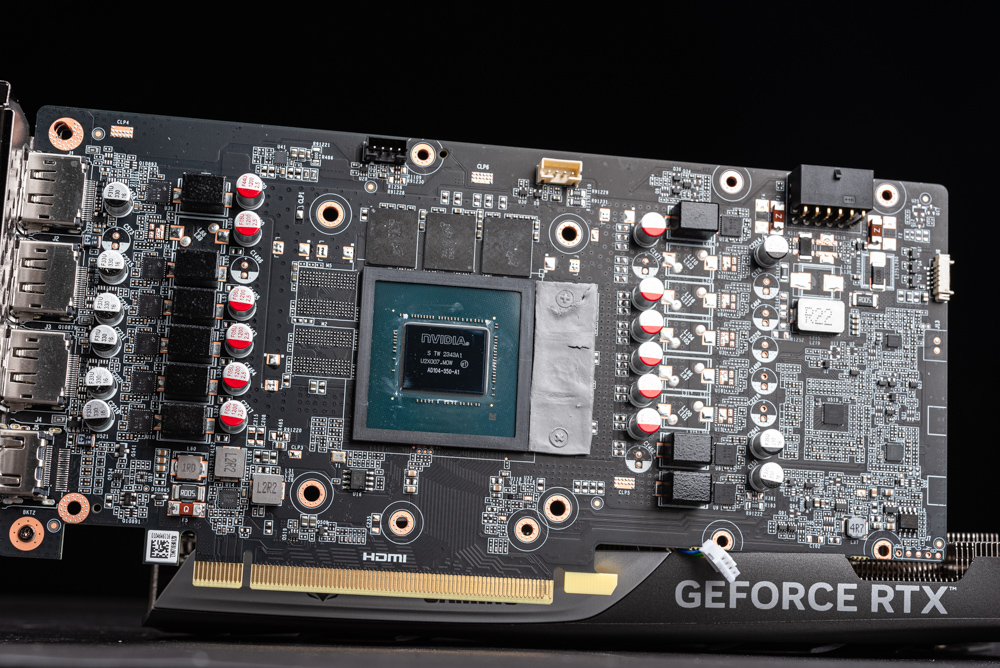
The ZOTAC GAMING GeForce RTX 4070 SUPER TWIN EDGE OC graphics card, focuses on its AD104-350-A1 GPU and the six GDDR6X memory modules. The AD104-350-A1 is part of NVIDIA’s Ampere architecture, which provides a significant performance boost over previous generations, particularly in ray-traced graphics and AI-enhanced tasks. The six GDDR6X memory modules are indicative of the card’s capacity to handle complex textures and large datasets efficiently, essential for high-resolution gaming and professional graphics work.
The visible capacitors, resistors, and VRMs (Voltage Regulator Modules) around the GPU and memory modules are crucial for maintaining stable power delivery and high-speed data processing. The meticulous layout and engineering of the PCB (Printed Circuit Board) demonstrate the quality and thought put into the design to ensure optimal electrical pathways and heat dissipation.
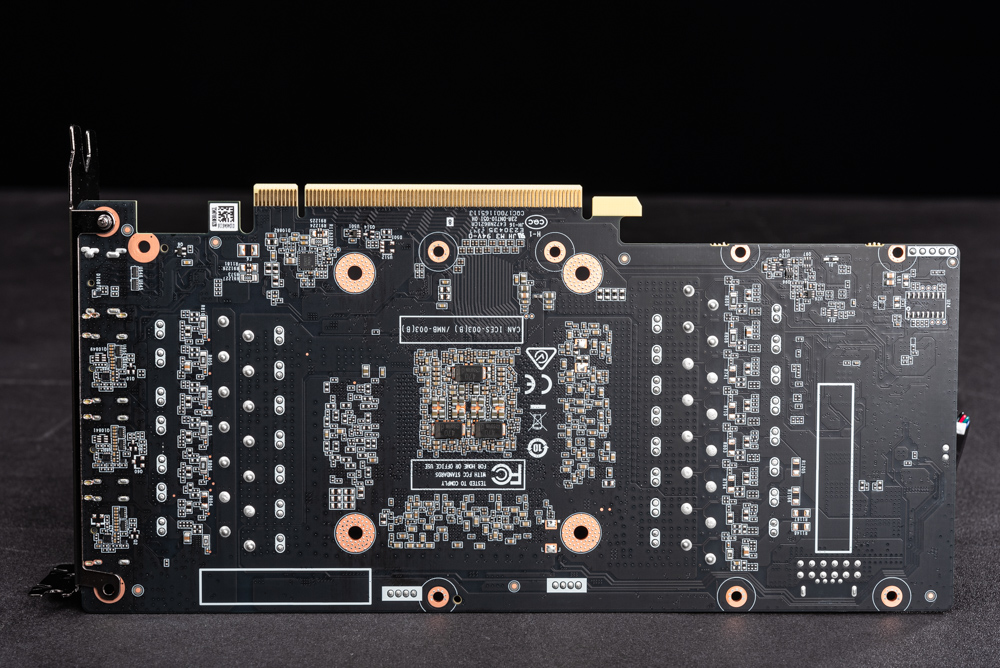
The back of the PCB (Printed Circuit Board) of a high-performance graphics card like the ZOTAC GAMING GeForce RTX 4070 SUPER TWIN EDGE OC. This side of the PCB often includes additional components, solder points, grounding areas, and sometimes thermal pads to help with heat dissipation.
In the case of this card, you can see the meticulous layout of the components and the clean traces on the PCB, which are indicative of a well-designed circuit that ensures optimal electrical flow and reduces interference. The use of copper for the contact points around the mounting holes signifies attention to detail in the design to maximize conductivity and heat transfer.
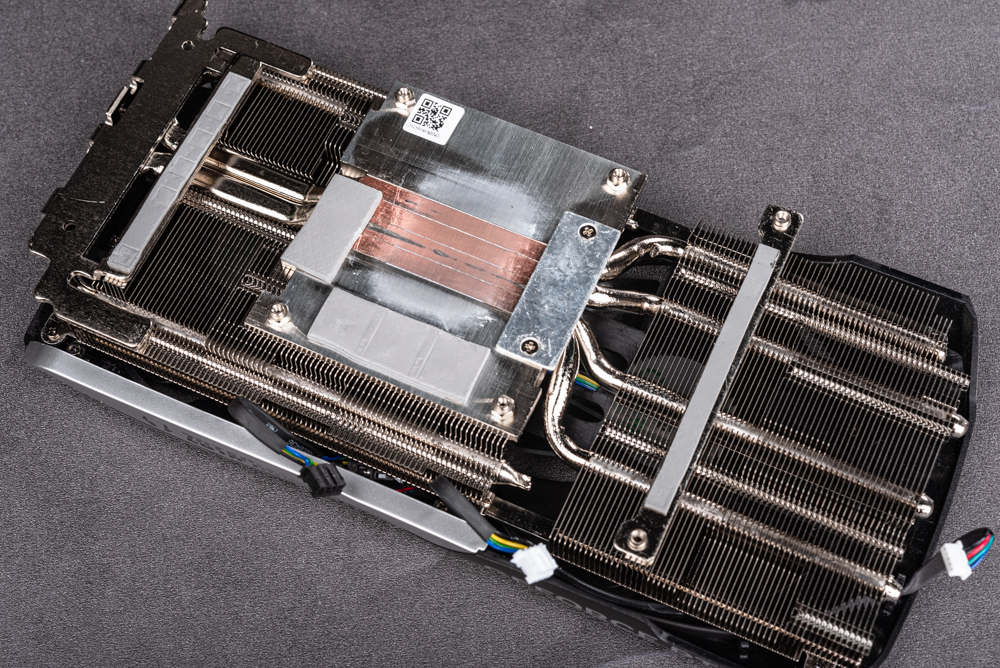
Depicts the heatsink of a high-performance graphics card, which is designed to effectively dissipate heat from the GPU. The cooling system features four heat pipes that make direct contact with the GPU, a method known as direct touch or direct contact heat pipes, which is efficient in transferring heat away from the GPU core to the heatsink fins.
These heat pipes are routed through two sets of aluminum fins, which provide a large surface area for heat dissipation. The design indicates that the cooling solution also takes into account the thermal management of surrounding components like memory and power delivery modules, which is crucial for maintaining overall system stability.
At the back of the heatsink, there appears to be a reinforcement bracket which is screwed to the PCIe bracket. This is an important structural feature that provides additional support to the card, ensuring that the weight of the cooler does not put excessive stress on the motherboard when the card is mounted horizontally in a PC case. This helps prevent PCB bending over time, which is a common issue with heavy aftermarket coolers.
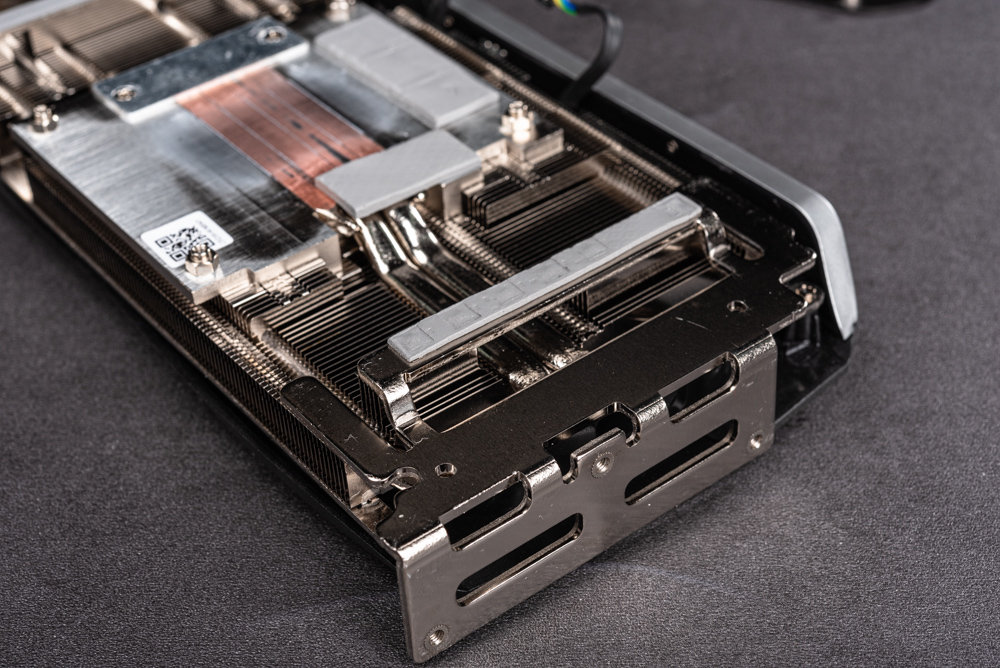
The heatsink’s reinforcement frame on a high-performance graphics card. This reinforcement frame is a critical structural component that adds rigidity to the graphics card, ensuring that the weight of the heatsink does not warp or damage the PCB (Printed Circuit Board) over time, especially when the card is mounted horizontally in a PC case.
This type of design is particularly important for heavier aftermarket cooling solutions, which can place significant stress on the motherboard and the graphics card’s PCB. The reinforcement frame also aids in the overall heat dissipation process by ensuring that the heatsink maintains proper contact with the GPU and other heat-generating components, preventing any potential loss of cooling efficiency due to bending or warping.
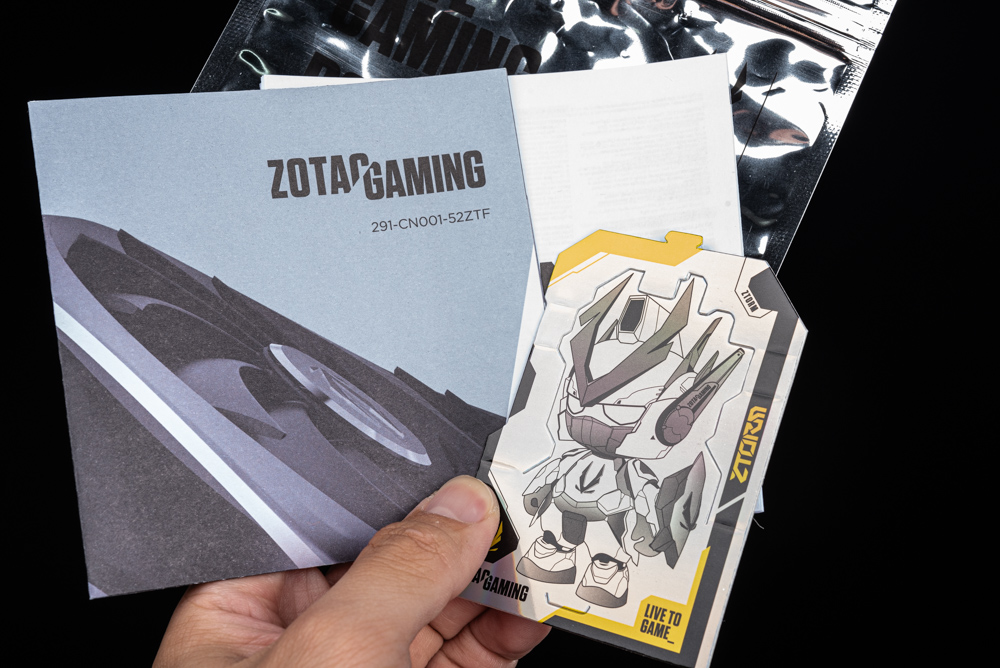
Appears as a graphics card accessory pack, which includes documentation from ZOTAC GAMING, and a small, collectible standee featuring a character or mascot associated with the brand. This kind of additional item is often included as a bonus for customers, serving as a fun, branded keepsake or a piece of desk art that fans and users of the product can display.
Including such personalized touches with hardware can enhance the user experience and build brand loyalty. It adds a sense of community and exclusivity, which is appealing to gamers and tech enthusiasts who often collect memorabilia related to their favorite tech brands.
Explore Zotac’s FireStorm: Advanced Tuning and Spectra RGB for NVIDIA RTX 40 Super Series
ZOTAC enhances the user experience with its FireStorm utility software, which is designed to be intuitive and user-friendly. This application allows users to fine-tune their graphics card settings for optimal performance. Within the Performance tab, users can adjust critical parameters such as the GPU clock speed, core voltage, and power limits. Such adjustments can unlock higher performance for demanding applications or help in achieving a balance between power consumption and noise levels.
The Fan Control tab offers flexibility in cooling management. Users can opt for the default auto-stop feature, which smartly stops the fans when the GPU is under a low-load condition, reducing noise. For those who prefer a hands-on approach, manual mode is available, allowing users to set a fixed fan speed. Moreover, for more dynamic control, users can define a custom fan curve, where fan speeds are adjusted based on temperature thresholds, ensuring efficient cooling under varying load conditions.
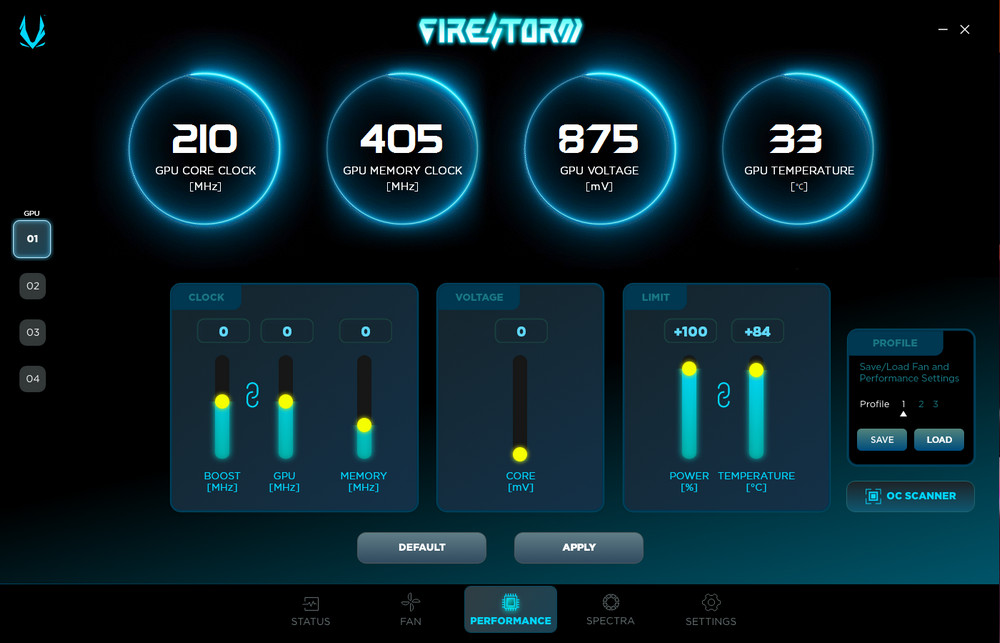
The interface of ZOTAC’s FireStorm utility software, is designed for performance tuning of their graphics cards. The interface shown highlights the various adjustable parameters within the software:
- GPU Core Clock (MHz)
- GPU Memory Clock (MHz)
- GPU Voltage (mV)
- GPU Temperature (°C)
There are sliders for tweaking the clock speeds of the GPU core and memory, as well as for adjusting the core voltage. Users also have the option to set limits for power and temperature, which helps in maintaining a balance between performance and the longevity of the card.
The interface provides a user-friendly and visually appealing means to access these settings. With real-time monitoring and the ability to save and load profiles, users can easily switch between different configurations for various use cases, such as gaming, rendering, or even mining.
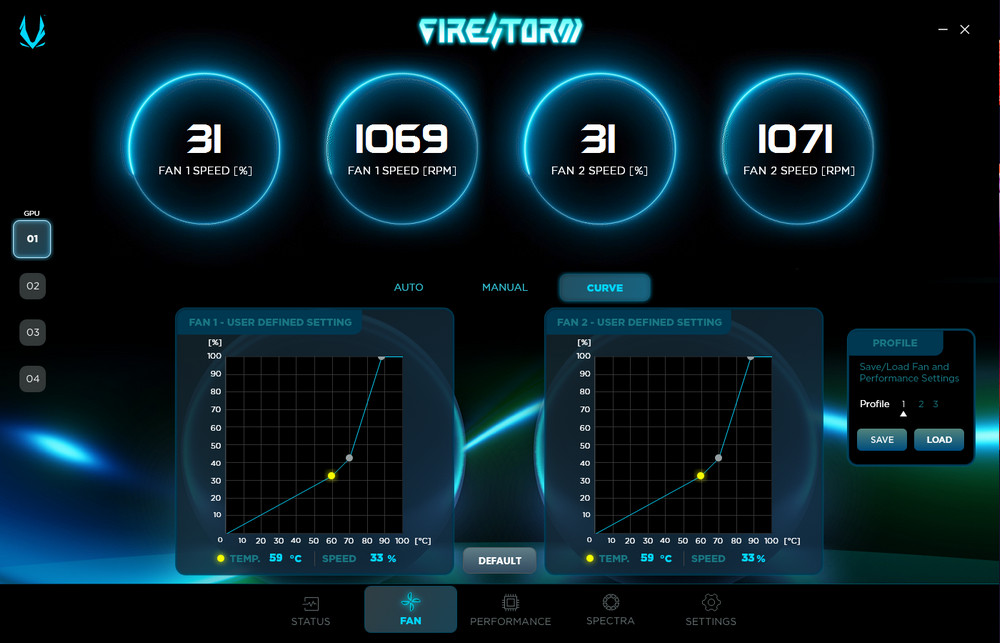
The fan control interface of ZOTAC’s FireStorm utility software. This section of the software allows users to monitor and adjust the fan speeds of their graphics card in real time. Displayed are two dials indicating the current fan speed in both percentage and RPM (Revolutions Per Minute) for two separate fans.
Below the dials, there are two graphs representing user-defined fan curves for each fan. These curves enable users to dictate how the fan speed should react to the GPU’s temperature, providing a way to customize the cooling efficiency and acoustic performance of the card. The graph shows temperature (°C) on the x-axis and fan speed (%) on the y-axis, with points on the curve that can be adjusted to trigger changes in fan speed at specific temperature thresholds.
Users can switch between automatic and manual control modes, and the ‘Curve’ button likely allows for more advanced customization of the fan profile. There’s also an option to save and load different profiles, which can be used to switch between custom settings for different types of workloads or gaming sessions.
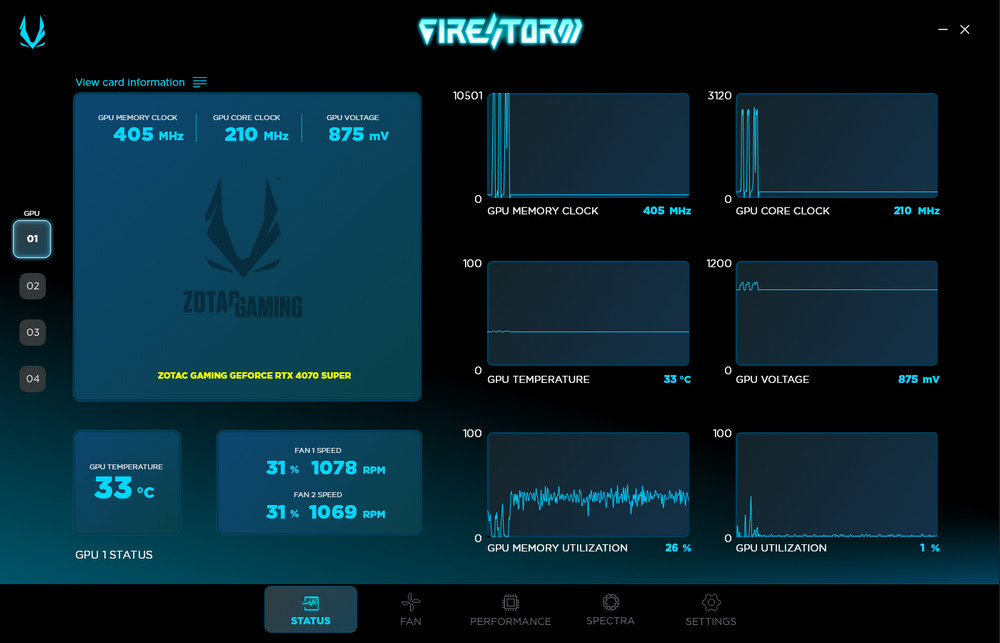
The status monitoring page of ZOTAC’s FireStorm utility software. This page provides real-time information on the graphics card’s current status, including usage percentages, clock speeds, temperatures, and other vital statistics. The interface is designed to give users an immediate overview of their GPU’s performance metrics, which can be crucial for diagnosing issues, optimizing settings, or simply keeping an eye on the system’s health.
The software includes a Spectra page, which is not shown in the image, where users can customize the RGB lighting effects and modes on their ZOTAC graphics card. This allows for personalization of the card’s aesthetics to match the user’s system theme or personal preference.
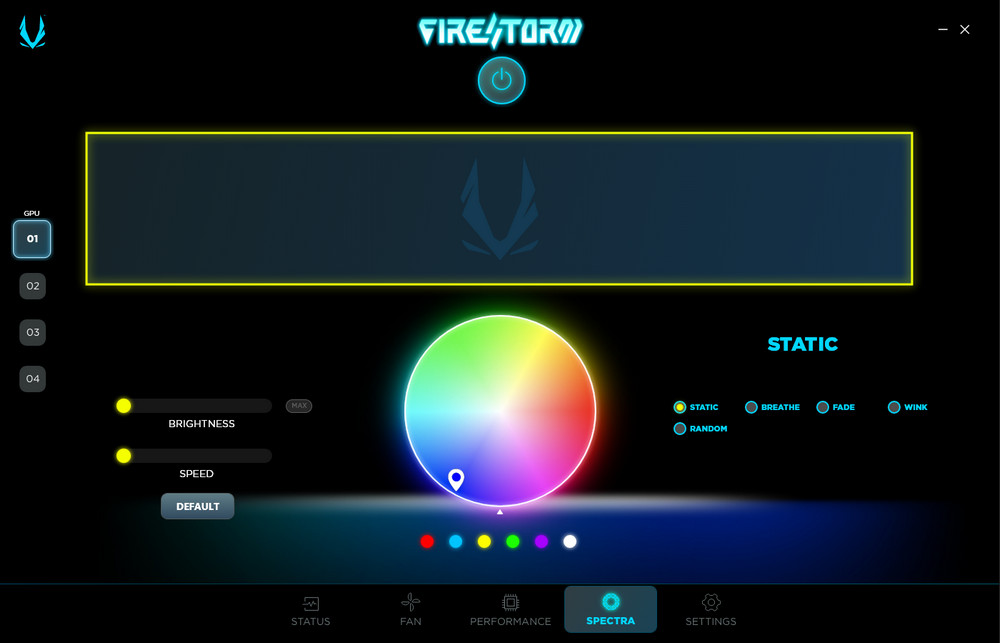
The Spectra RGB lighting control feature within ZOTAC’s FireStorm utility software. This interface allows users to personalize the RGB lighting on their ZOTAC gaming graphics card by adjusting colors, brightness, and lighting effects. Users can select from a color wheel for a custom hue, and choose effects such as static, breathing, fading, or blinking, along with a random mode for varied lighting. The sliders for brightness and speed further customize the lighting to match the user’s preference or to sync with their gaming setup’s overall aesthetic.
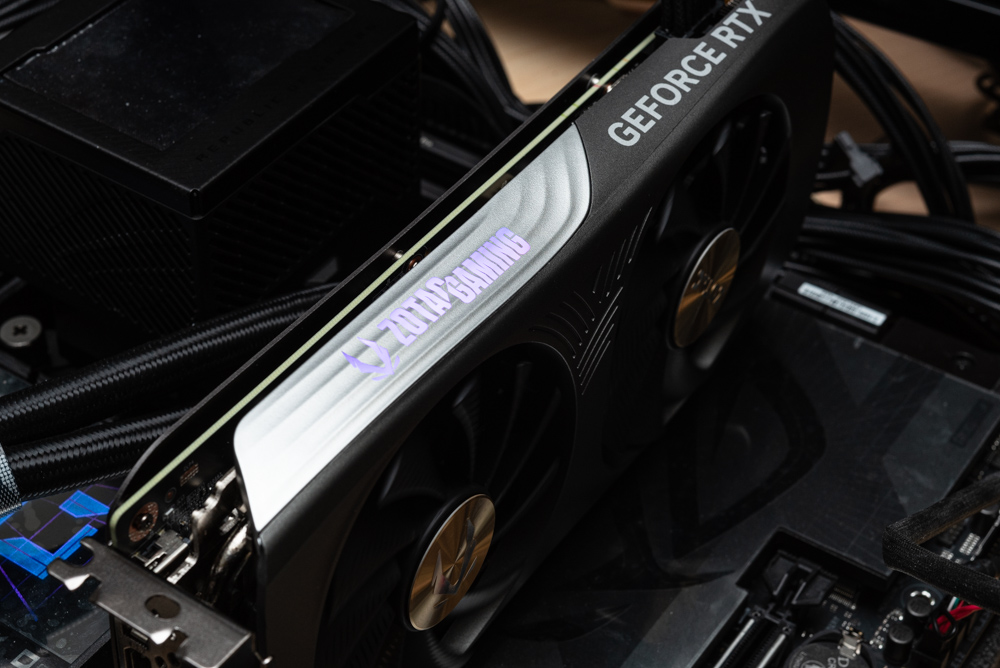
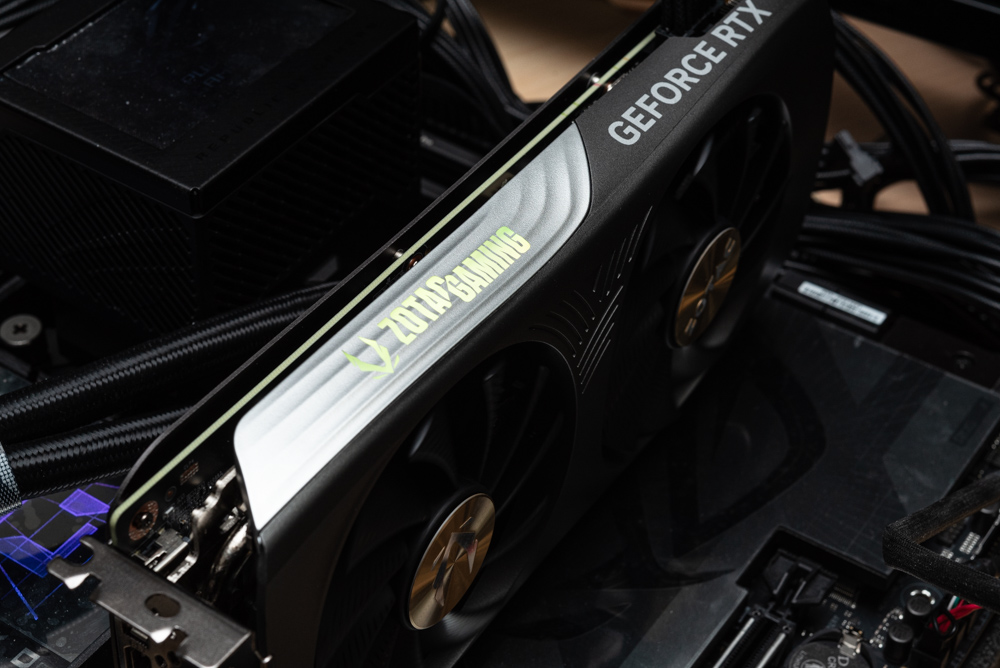
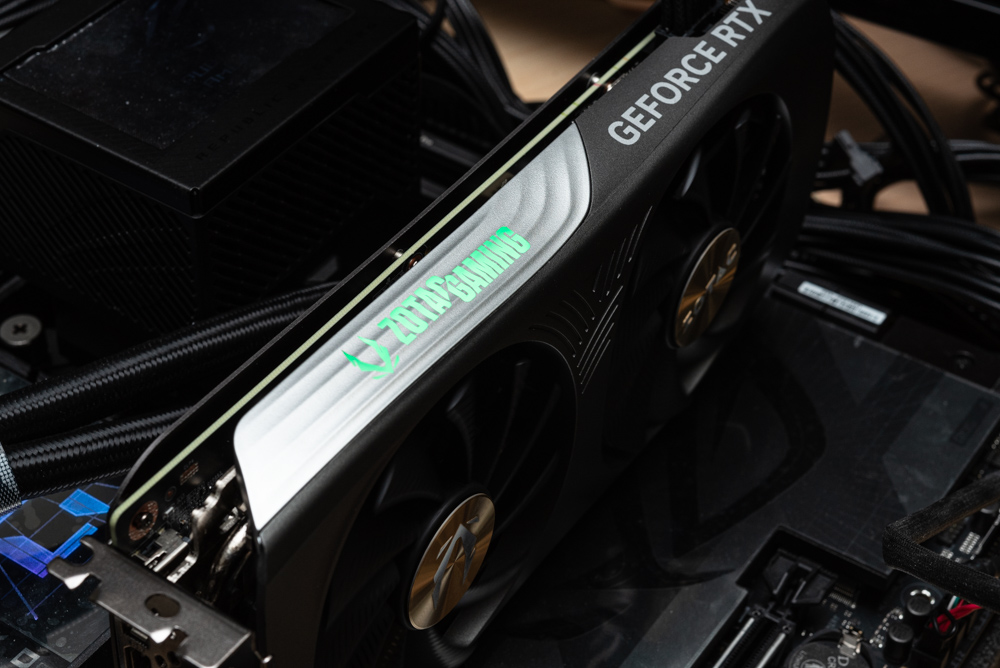
The RGB lighting effects on a ZOTAC GAMING GeForce RTX graphics card installed in a computer system. The illuminated logo and branding on the side of the card are part of the customizable RGB lighting that can be managed via ZOTAC’s FireStorm software. The lighting provides a stylish accent to the card, enhancing the visual appeal of the gaming rig.
Comprehensive Benchmark Review: NVIDIA RTX 4070 Super Excels in Creative and Gaming Tests at 1440p and 2160p Resolutions
The ZOTAC GAMING GeForce RTX 4070 SUPER TWIN EDGE OC graphics card is being put through a comprehensive set of benchmarks to evaluate its performance across various creative applications and gaming scenarios. The tests include:
- Creative applications like Adobe Photoshop (PS), Adobe Lightroom (LR), and Blender to gauge the card’s capability in content creation workflows.
- Gaming performance at high resolutions of 1440p and 2160p (4K) with maximum graphical settings to test the card’s capability in competitive esports titles, AAA games, and ray-tracing-enabled titles.
- The performance impact and benefits of DLSS 3, NVIDIA’s latest deep learning super sampling technology designed to boost frame rates while maintaining high image quality.
The test platform is a high-end setup that includes:
- Processor: Intel Core i9-14900K
- Motherboard: ASUS ROG MAXIMUS Z790 DARK HERO
- Memory: Crucial Pro DDR5 5600 32GBx2
- Graphics Card: ZOTAC GAMING RTX 4070 SUPER TWIN EDGE OC
- System Drive: Solidigm P44 Pro 1TB PCIe 4.0 SSD
- Cooler: ASUS ROG RYUJIN III 360
- Power Supply: Seasonic FOCUS GX (ATX3.0) 750W
- Operating System: Windows 11 Pro 21H2 64bit with Resizable BAR On
Regarding the GPU, although GPU-Z may not yet display the NVIDIA GeForce RTX 4070 Super’s information, the card is known to use a 5nm manufacturing process for the AD104 GPU, which features 7168 CUDA cores for rendering and 12288 MB of GDDR6 memory from Micron. The GPU’s default clock is set at 1980 MHz with a boost clock of 2475 MHz.
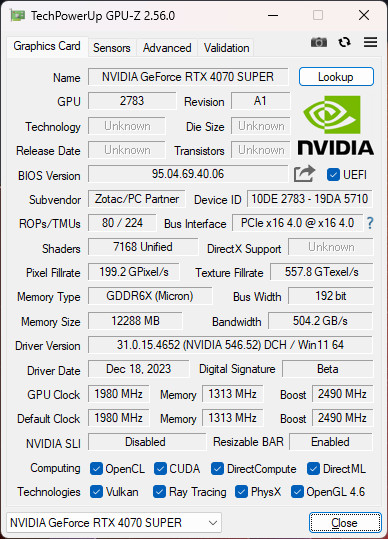
A screenshot of the TechPowerUp GPU-Z utility displaying the specifications and details of the NVIDIA GeForce RTX 4070 SUPER graphics card, presumably the ZOTAC variant given the subvendor information. The details presented in GPU-Z typically include:
- The exact model of the GPU.
- The BIOS version.
- The die size, release date, and transistor count if available.
- The number of ROPs/TMUs and shaders (CUDA cores).
- Clock speeds, including the GPU’s base clock and boost clock.
- The type and size of memory, as well as the memory clock and bandwidth.
- The driver version and DirectX support.
- Support for different technologies like NVIDIA SLI, G-Sync, Ray Tracing, and others.
This information is valuable for enthusiasts and professionals as it confirms the capabilities and features of the graphics card. It also provides technical confirmation for the overclocking potential and compatibility with other technologies, like Resizable BAR, which can improve performance in certain scenarios.
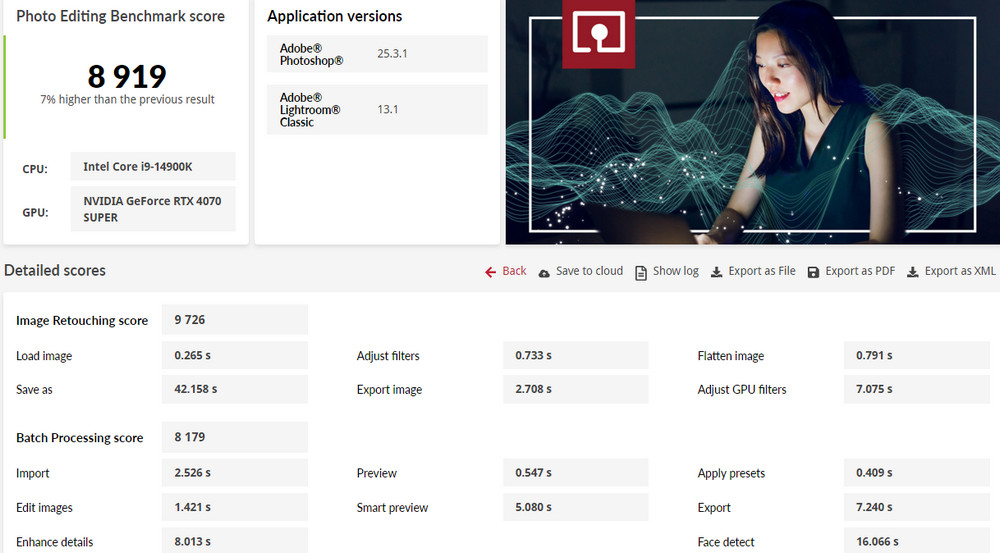
From a benchmarking result using the UL Procyon Photo Editing Benchmark tool, which assesses performance in Adobe Photoshop and Lightroom Classic. This particular benchmark measures the efficiency of a system in two distinct scenarios:
- Image Retouching Test: This test uses Photoshop for detailed photo retouching tasks and records the time taken to complete each step. The result reflects the system’s capability to handle intricate image editing tasks that are common in professional workflows.
- Batch Processing Test: This test involves using Lightroom to adjust and export a large number of photos in a batch. This score reflects the system’s ability to efficiently process multiple images, a common requirement for photographers and content creators who need to manage large libraries of digital photos.
The NVIDIA GeForce RTX 4070 SUPER, combined with an Intel Core i9-14900K CPU, has achieved a score of 8919 points. The detailed scores show a high performance in image retouching (9726 points) and a strong result in batch processing (8179 points). These scores are indicative of the system’s robust performance in creative tasks and would be particularly appealing to professionals in the photography and digital content creation sectors.
In creating content or reporting on these benchmark results, it would be beneficial to highlight the significance of these scores for creative professionals and enthusiasts.
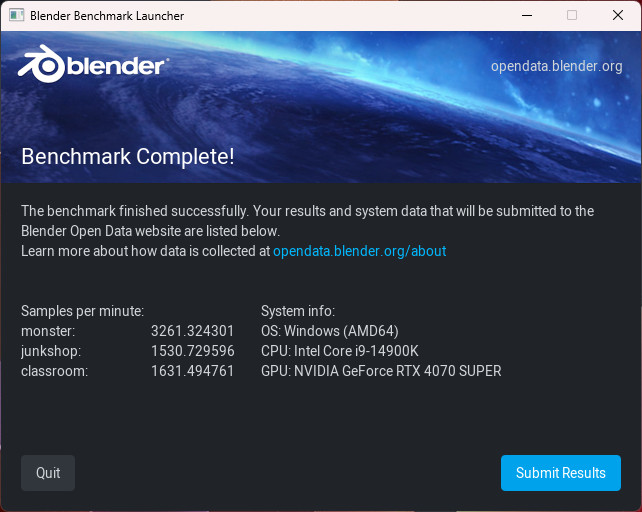
From a Blender Benchmark test, which is a performance measuring tool for Blender, the open-source 3D creation suite. Blender supports a wide range of 3D tasks including modeling, rigging, animation, simulation, rendering, compositing, and motion tracking. The benchmark test provides an evaluation of how well the hardware can handle these intensive tasks by measuring the number of samples it can process per minute during rendering.
The NVIDIA GeForce RTX 4070 SUPER has achieved the following samples per minute in the test:
- Monster: 3261.324
- Junkshop: 1530.729
- Classroom: 1631.494
These results are indicative of the rendering performance of the RTX 4070 SUPER, showcasing its capability to handle complex 3D rendering tasks efficiently. The “Monster” scenario, in particular, seems to have a high samples-per-minute count, indicating strong performance.
For content aimed at 3D artists, animators, or anyone interested in CGI work, these results can be highlighted to show the potential time savings and increased productivity that this GPU can offer.
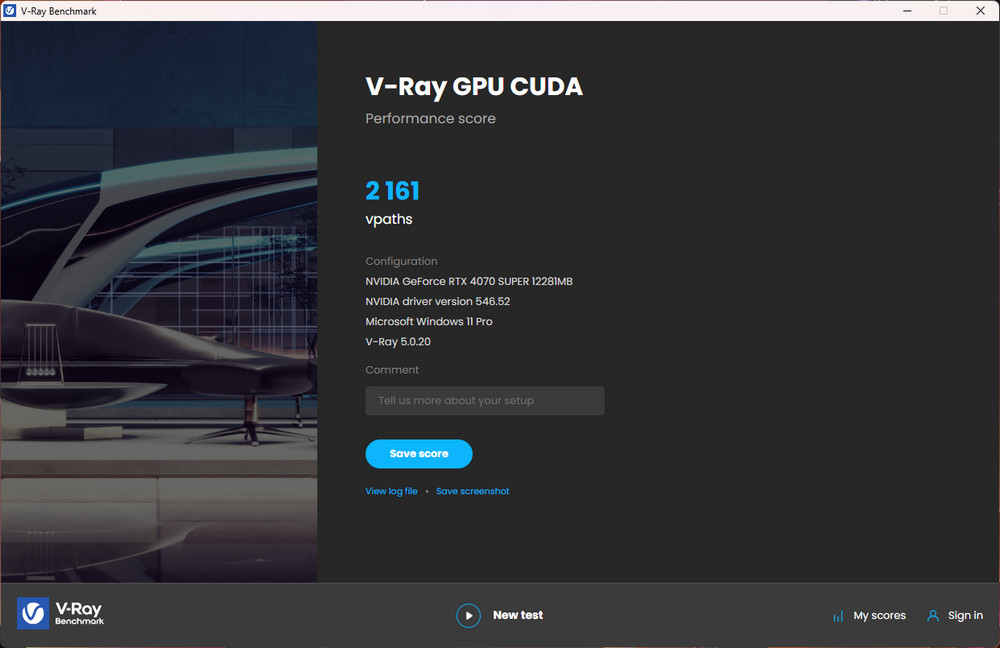
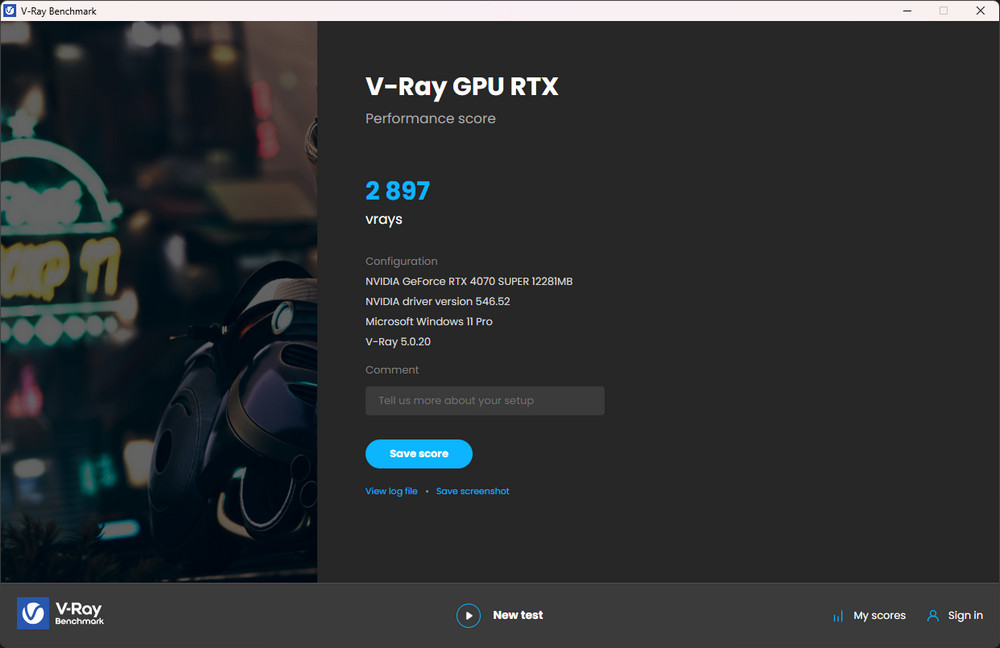
The results of the V-Ray Benchmark from Chaos Group, a performance test for the V-Ray rendering engine. V-Ray is a physically-based renderer known for its ability to simulate realistic lighting and materials in computer graphics. The benchmark measures the rendering performance of both CPUs and GPUs using ray tracing technology.
In the results, the NVIDIA GeForce RTX 4070 SUPER has achieved two different scores:
- A score of 2897 vpaths for RTX compute performance.
- A score of 2161 vpaths for CUDA compute performance.
These scores represent the GPU’s capability in handling ray tracing operations, with RTX being NVIDIA’s dedicated ray tracing technology that leverages the RT cores in the GPU. CUDA, on the other hand, refers to NVIDIA’s parallel computing platform and application programming interface (API) model, which can also be used for tasks such as ray tracing and general computing operations.
These results would be significant to professionals and enthusiasts in fields like 3D animation, visual effects, and architectural visualization, where V-Ray is commonly used.
Stable Diffusion with RTX 4070 Super: Achieving Peak GPU Acceleration and Enhanced Image Generation Speeds
Stable Diffusion is a prominent AI deep-learning model that has gained widespread attention for its ability to generate images from textual descriptions. The model you’re referring to, released by Automatic1111, appears to be a manually installed version that includes optimizations for enhanced GPU acceleration through TensorRT.
TensorRT is a high-performance deep learning inference platform that significantly improves the efficiency of deep learning models by optimizing neural network layers and executing them on NVIDIA GPUs. The integration of TensorRT with Stable Diffusion would enable the model to operate with improved performance, leveraging the power of the GPU to accelerate the generation of images from text.
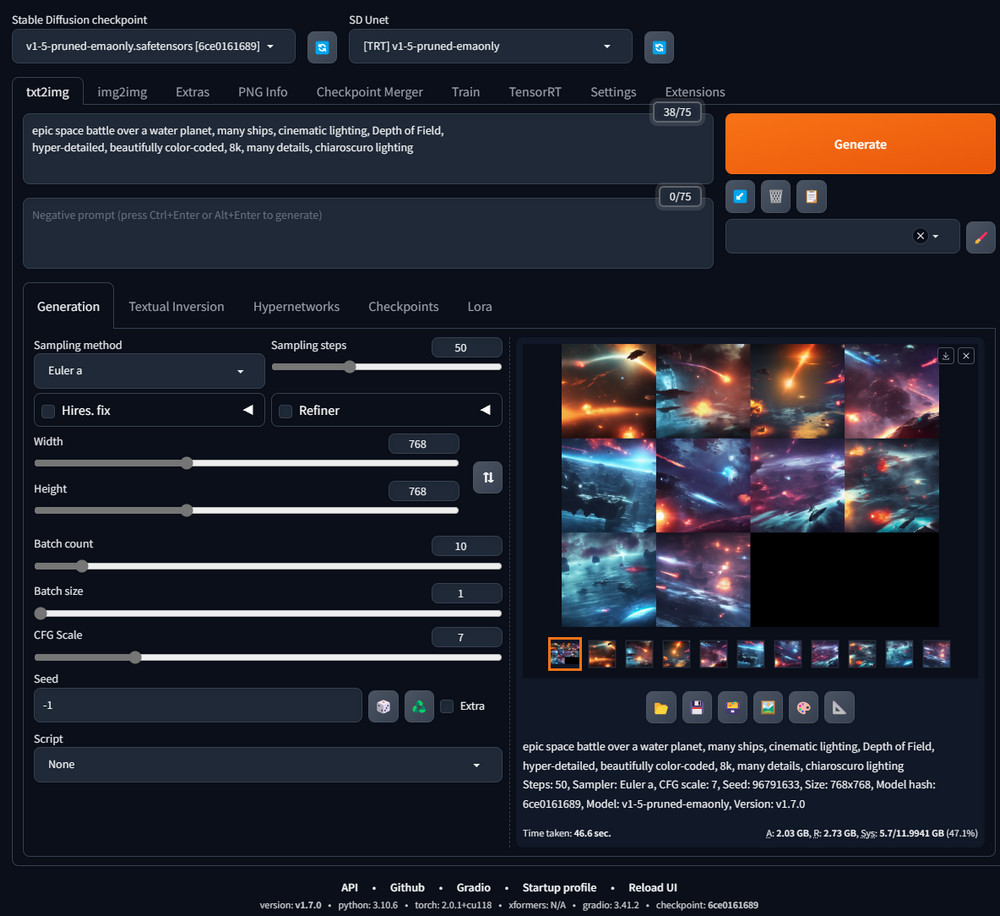
The web interface for Stable Diffusion, a text-to-image AI model that has been optimized to run with TensorRT for GPU acceleration. This user interface is part of the Automatic1111 web UI version, which is a user-friendly front end for interacting with the Stable Diffusion model.
The interface allows users to input text prompts, control various parameters such as the number of sampling steps, image dimensions, and batch count, and adjust the CFG scale, which influences the creativity of the results. It also shows the generated images based on the input prompt, which in this case, describes an “epic space battle over a water planet, many ships, cinematic lighting, Depth of Field, hyper-detailed, beautifully color-coded, 8k, many details, chiaroscuro lighting.”
The interface includes a timer that records how long it takes to generate the images, providing users with performance metrics. This kind of tool is particularly useful for artists, designers, and creators who are looking to explore AI-generated artwork or need visual content that would be time-consuming to create manually.
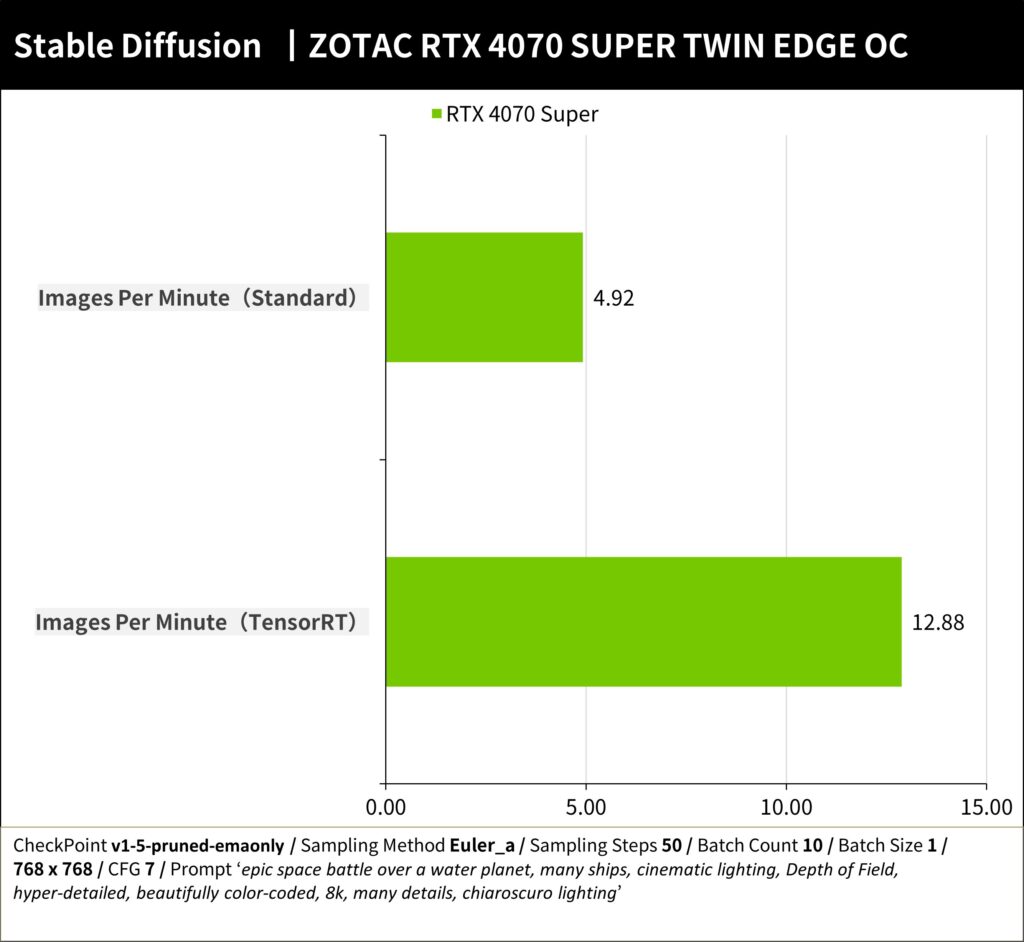
For the ZOTAC RTX 4070 SUPER TWIN EDGE OC graphics card running the Stable Diffusion AI model with TensorRT optimization. According to the data, with TensorRT enabled, the RTX 4070 Super can generate images at a rate of 12.88 images per minute. This is a substantial improvement over the standard Automatic1111 version, which generates 4.92 images per minute, marking a 162% increase in performance.
This significant performance enhancement demonstrates the advantage of using GPU acceleration technologies like TensorRT to optimize AI models for faster computation. For individuals or businesses that rely on rapid image generation, this level of performance could greatly increase productivity and creative output.
Exceptional Performance Unveiled: NVIDIA RTX 4070 Super Dominates in 3DMark Fire Strike, Time Spy, and Ray Tracing Benchmarks
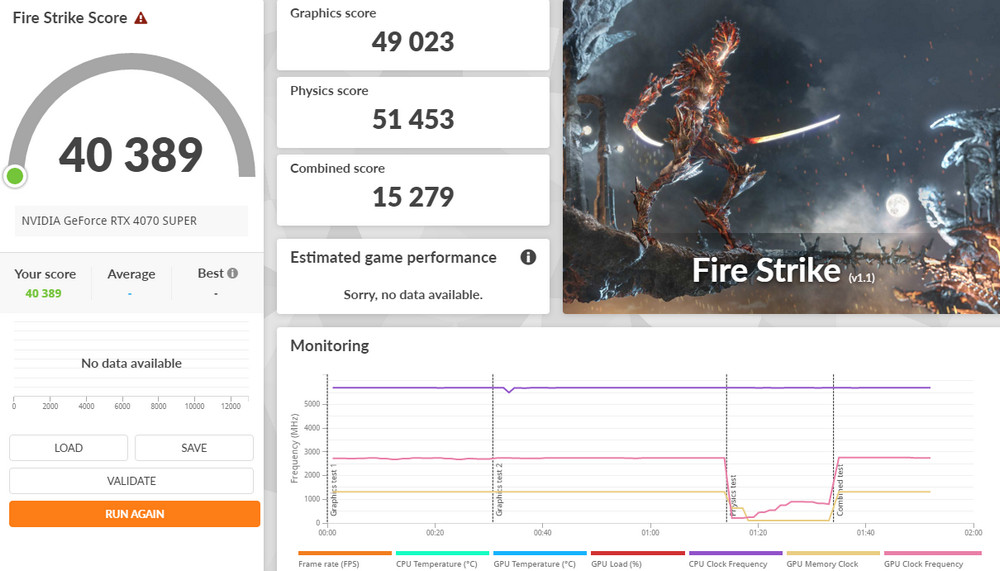
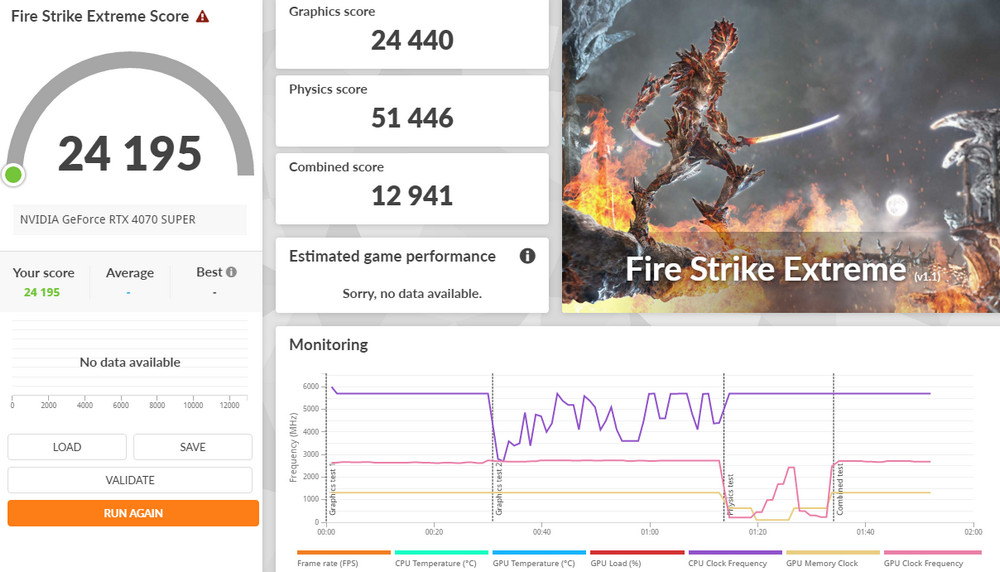
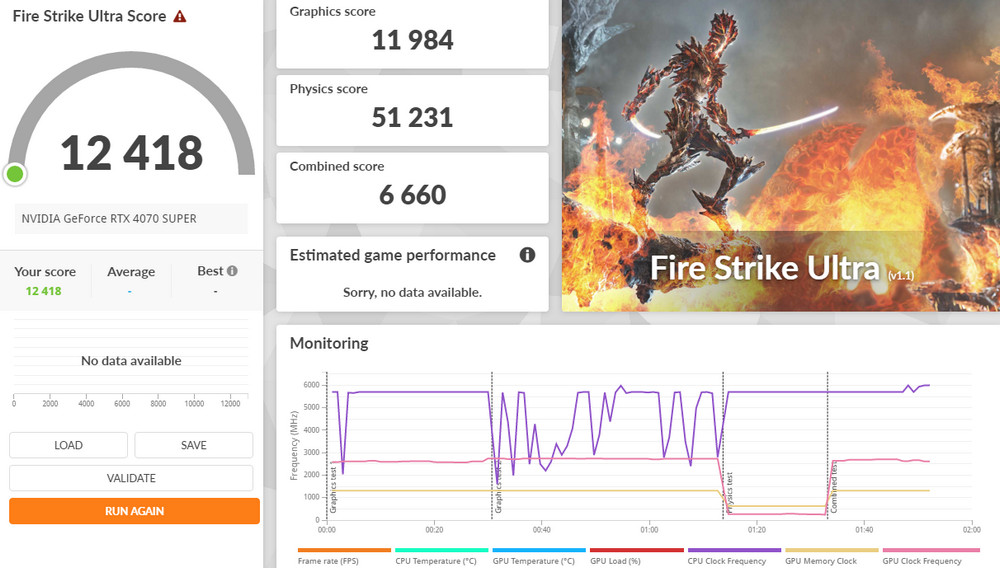
Three screenshots from 3DMark Fire Strike benchmark results for the NVIDIA GeForce RTX 4070 SUPER. These results show the performance at different resolutions:
- The first image represents the Fire Strike score which is a standard test at 1080p.
- The second image shows the Fire Strike Extreme score, which is a more demanding test at 1440p.
- The third image depicts the Fire Strike Ultra score, the most demanding test in this suite at 4K or 2160p resolution.
Given the results:
- In Fire Strike (1080p), the RTX 4070 SUPER scored 49,023 points for graphics.
- In Fire Strike Extreme (1440p), it scored 24,440 points for graphics.
- In Fire Strike Ultra (2160p), it scored 11,984 points for graphics.
These scores are indicative of strong performance, especially in the context of a mid-range card like the RTX 4070 SUPER, showing its capability to handle different gaming resolutions from 1080p to 4K.
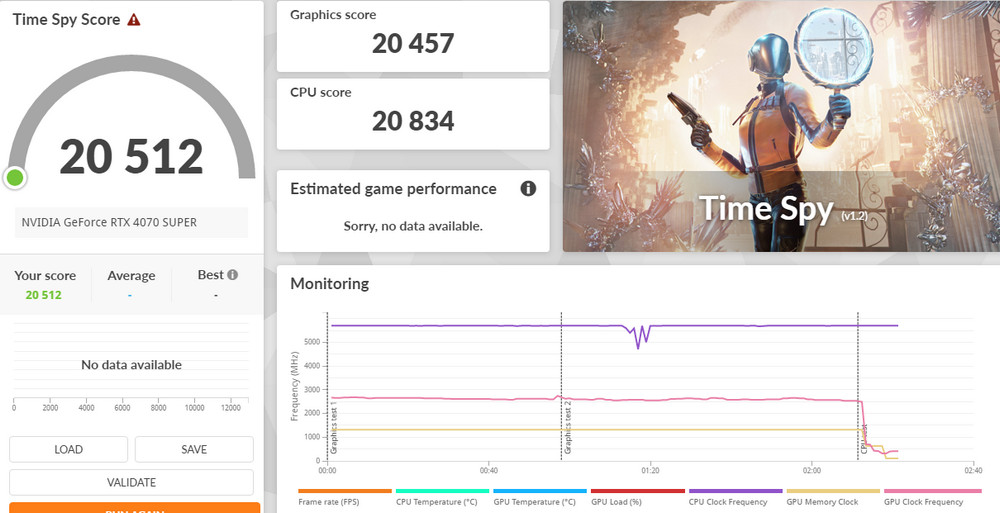
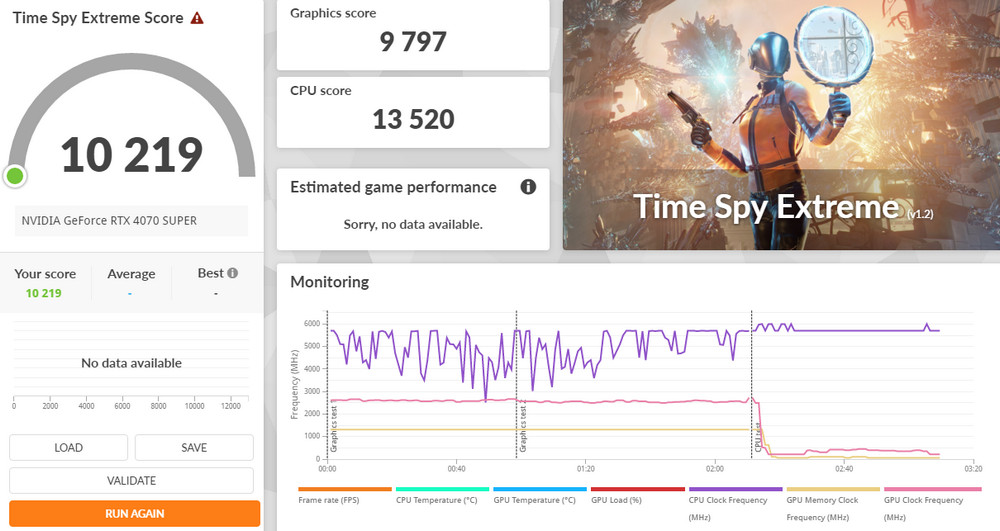
The 3DMark Time Spy and Time Spy Extreme benchmark scores for the NVIDIA GeForce RTX 4070 SUPER graphics card.
In the Time Spy benchmark, which tests DirectX 12 API performance at 1440p:
- The RTX 4070 SUPER achieved a graphics score of 20,457 and an overall score of 20,512.
In the Time Spy Extreme benchmark, which tests DirectX 12 API performance at 4K or 2160p:
- The RTX 4070 SUPER achieved a graphics score of 9,797 and an overall score of 10,219.
These scores indicate that the RTX 4070 SUPER is capable of handling high-fidelity gaming at both 1440p and 4K resolutions, with high performance in DirectX 12 environments.
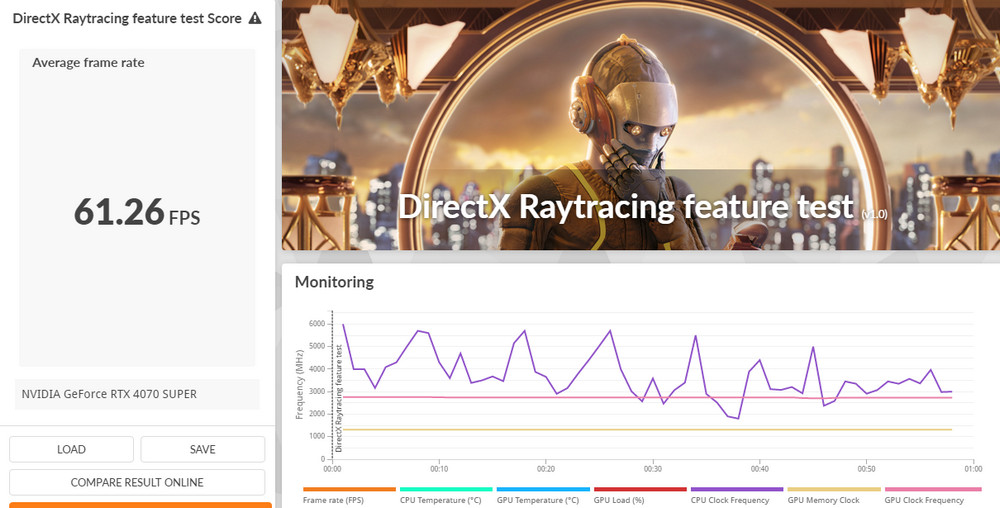
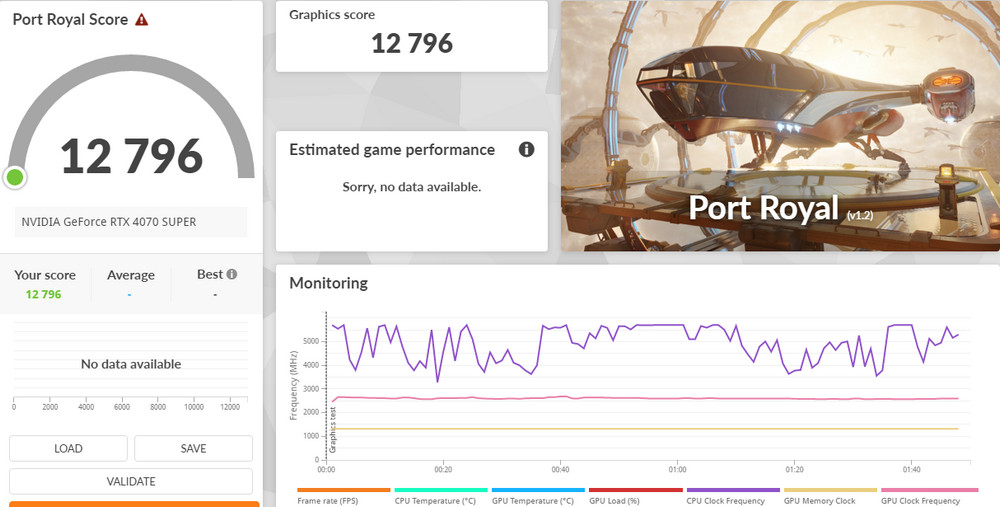
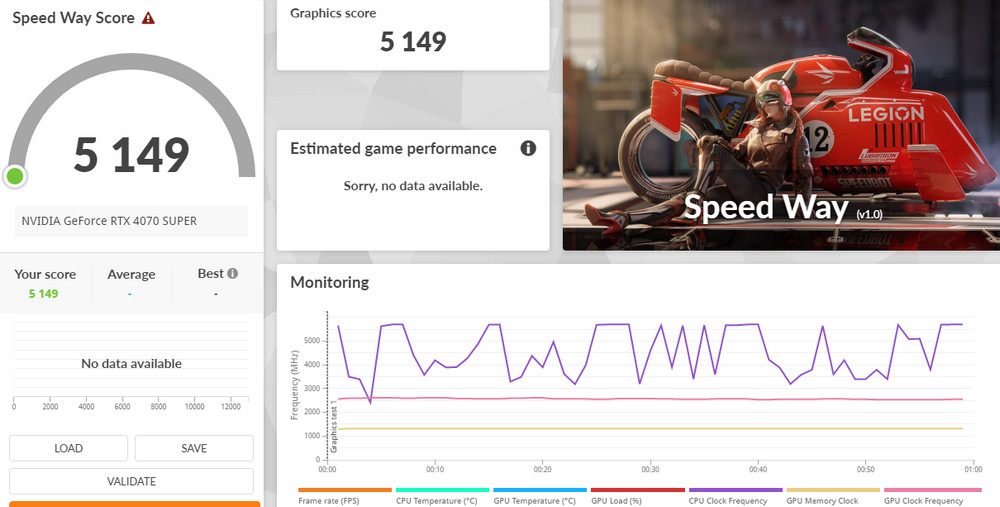
The benchmark results from 3DMark tests focused on ray tracing performance, specifically Port Royal and the DirectX Raytracing feature test, as well as the Speed Way test, which I understand are designed to measure a GPU’s ray tracing capabilities.
From the information provided in the text and images:
- In the DirectX Raytracing feature test, the RTX 4070 SUPER achieved an average frame rate of 61.26 FPS.
- In the Port Royal test, which integrates ray tracing in AAA game-like scenarios, the RTX 4070 SUPER scored 12,796 points.
- In the Speed Way test, which is developed entirely with ray tracing, the RTX 4070 SUPER scored 5,149 points.
These results demonstrate that the RTX 4070 SUPER is quite capable of handling ray tracing in gaming scenarios, delivering respectable frame rates and scores, especially considering ray tracing is a computationally intensive task. This speaks to the card’s performance and effectiveness in rendering high-quality graphics with advanced lighting and reflection effects.
RTX 4070 Super Shines in Esports: Stellar 1440p and 2160p Performance in Top Competitive Games
The information provided suggests that the ZOTAC RTX 4070 SUPER TWIN EDGE OC graphics card has been tested on four popular competitive and esports titles: “Rainbow Six Siege,” “League of Legends,” “Apex Legends,” and “Counter-Strike 2.” These games are known for requiring skill and team tactics and typically do not demand the highest graphical details, which allows for high frames per second (FPS) performance even on higher resolutions.
The tests were conducted at resolutions of 1440p and 2160p (4K) with the highest graphical settings. The RTX 4070 Super delivered excellent performance, averaging above 100 FPS in all tests, which is indicative of its capability to handle the demands of competitive gaming. Specifically, in “Counter-Strike 2,” it achieved an average of 271 FPS at 1440p and 135 FPS at 2160p, while “Apex Legends” reached an average of 258 FPS at 1440p and 180 FPS at 2160p.
For esports gamers, these figures are particularly important as high FPS can contribute to a smoother gaming experience and may provide a competitive edge.
RTX 4070 Super Delivers Impressive 1440p and 4K Performance in AAA Gaming Benchmarks Without Ray Tracing or DLSS
The ZOTAC RTX 4070 SUPER TWIN EDGE OC graphics card was put through a rigorous testing phase with a selection of AAA gaming titles at both 1440p and 2160p (4K) resolutions with maximum graphical settings. During this test, only “F1 2022” had ray tracing enabled, while the others did not utilize ray tracing or DLSS (Deep Learning Super Sampling), aiming to assess the card’s performance in traditional rendering scenarios.
The test suite included a variety of games that span different genres and graphical demands:
- Newly released titles such as “Diablo IV” and “Avatar: Frontiers of Pandora.”
- Popular entries like “F1® 22,” “Shadow of the Tomb Raider,” and “Horizon Zero Dawn.”
- Graphically intensive games like “Borderlands 3,” “Assassin’s Creed Valhalla,” “Red Dead Redemption 2,” and “God of War.”
At 1440p, the RTX 4070 Super achieved an average of 126.04 FPS across these titles, delivering more than adequate performance for a high-end gaming experience:
- “Diablo IV”: 154 FPS
- “Avatar: Frontiers of Pandora”: 80 FPS
- “Red Dead Redemption 2”: 103.86 FPS
- “God of War”: 109 FPS
Moving to 4K resolution, the card still managed an average of 71.42 FPS, which is impressive, though naturally lower than at 1440p due to the increased demand for 4K rendering. The only game that struggled somewhat was “F1® 22” with ray tracing on by default, but even this can be mitigated with DLSS, which uses AI to upscale lower-resolution images in real-time, providing smoother frame rates at higher resolutions.
In summary, the RTX 4070 Super shows a notable performance increase, making it more suitable as an entry-level 4K gaming card compared to the original RTX 4070. It’s recommended to pair it with DLSS for 4K gaming to ensure a more stable and fluid performance.
RTX 4070 Super Masters Ray Tracing: Exceptional 1440p and 4K DLSS-Boosted Performance in Top DXR Games
The ZOTAC RTX 4070 SUPER TWIN EDGE OC graphics card’s performance in a suite of nine DirectX Raytracing (DXR) enabled games at both 1440p and 2160p resolutions, with maximum graphical and ray tracing settings. The test also incorporates DLSS (Deep Learning Super Sampling) to boost performance, a technology that is especially beneficial when ray tracing is enabled, as it can significantly impact frame rates.
The selection of games used for the test includes a mix of newly released titles, modern classics that have been updated with ray tracing, and graphically demanding AAA games:
- “The Witcher 3: Wild Hunt”
- “Star Wars Jedi: Survivor”
- “Hogwarts Legacy”
- “Portal with RTX” (an NVIDIA-modded version with ray tracing)
- “Cyberpunk 2077”
- “Control”
- “Spider-Man: Miles Morales”
- “Marvel’s Guardians of the Galaxy”
- “Far Cry 6”
With DLSS 3 acceleration at 1440p, the RTX 4070 Super managed to achieve remarkable frame rates, exemplified by the average FPS scores in some highlighted games:
- “The Witcher 3: Wild Hunt”: 128 FPS
- “Portal with RTX”: 113 FPS
- “Cyberpunk 2077”: 145.1 FPS
The average across all nine ray-traced games was 134.6 FPS at 1440p, indicating strong performance in demanding gaming scenarios.
At the more challenging resolution of 2160p (4K), the card achieved an average of 79.2 FPS, which, while lower than the 1440p scores, still suggests that the RTX 4070 Super is a viable option for entry-level 4K gaming. However, some games may not run as smoothly at this resolution, underscoring the need for technologies like DLSS to maintain a fluid gaming experience.
RTX 4070 Super TWIN EDGE OC Endures: Power and Thermal Efficiency Tested with Speed Way, Furmark, and Cyberpunk 2077
A series of stress tests were conducted to evaluate the power consumption and temperature performance of the ZOTAC RTX 4070 SUPER TWIN EDGE OC graphics card. These tests are crucial for users who are concerned about the thermal and energy efficiency of their hardware, especially in high-load scenarios such as gaming or intensive graphical computations.
For the temperature assessment, the card was subjected to rigorous stress tests, and it maintained a peak temperature of 69°C, which indicates good thermal performance and suggests that the card’s cooling solution is effectively dissipating heat.
Power consumption was measured using NVIDIA’s PACT tool, which monitors the wattage supplied through the PCIe slot and the 12V power connectors. During the Speed Way Stress test and the Furmark 4K Xtreme burn-in, the card’s average power draw was 213.7W. This figure is within the expected range for a high-performance card like the RTX 4070 Super and aligns with its Total Board Power (TBP) rating.
Summarize
The ZOTAC GAMING RTX 4070 SUPER TWIN EDGE OC is portrayed as a robust option for gamers aiming for high performance at 1440p (also referred to as 2K) resolution. With average frame rates of 126.04 FPS in AAA titles and 134.6 FPS in ray tracing games, it offers a significant performance boost suitable for high-fidelity gaming experiences. The card also presents itself as an entry-level option for 4K gaming, with a performance increase of approximately 10-14% over the original RTX 4070, making it a solid choice for gamers looking to step into the 4K realm.
Regarding pricing, the RTX 4070 SUPER TWIN EDGE OC is mentioned to have a manufacturer’s suggested retail price (MSRP), and the expected price in Taiwan dollars is around TWD 21,990. This positions the card as an investment for gamers with the budget to seek additional gaming performance. For those looking for value, the now-discounted RTX 4070 remains a viable choice, offering a balance of cost and capability.
If this article is helpful for you, please share this article with your friends on social media. Thank you!
This article is based on the personality of the reviews. You are responsible for fact-checking if the contents are not facts or accurate.
Title: Enhance Your Gaming Experience: ZOTAC RTX 4070 SUPER TWIN EDGE OC Comprehensive Analysis